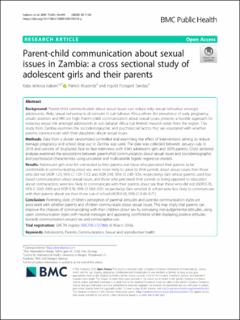| dc.contributor.author | Isaksen, Katja | |
| dc.contributor.author | Musonda, Patrick | |
| dc.contributor.author | Sandøy, Ingvild Fossgard | |
| dc.date.accessioned | 2021-02-25T10:13:35Z | |
| dc.date.available | 2021-02-25T10:13:35Z | |
| dc.date.created | 2020-10-01T12:50:03Z | |
| dc.date.issued | 2020 | |
| dc.Published | BMC Public Health. 2020, 20 (1), 1120-?. | |
| dc.identifier.issn | 1471-2458 | |
| dc.identifier.uri | https://hdl.handle.net/11250/2730327 | |
| dc.description.abstract | Background
Parent-child communication about sexual issues can reduce risky sexual behaviour amongst adolescents. Risky sexual behaviour is of concern in sub-Saharan Africa where the prevalence of early pregnancy, unsafe abortion and HIV are high. Parent-child communication about sexual issues presents a feasible approach for reducing sexual risk amongst adolescents in sub-Saharan Africa but limited research exists from the region. This study from Zambia examines the sociodemographic and psychosocial factors that are associated with whether parents communicate with their daughters about sexual issues.
Methods
Data from a cluster randomized controlled trial examining the effect of interventions aiming to reduce teenage pregnancy and school drop out in Zambia was used. The data was collected between January–July in 2018 and consists of structured, face to face interviews with 4343 adolescent girls and 3878 parents. Cross sectional analyses examined the associations between parent-child communication about sexual issues and sociodemographic and psychosocial characteristics using univariate and multivariable logistic regression models.
Results
Adolescent girls who felt connected to their parents and those who perceived their parents to be comfortable in communicating about sex, were more likely to speak to their parents about sexual issues than those who did not (AOR 1.23, 95% CI 1.01–1.52; and AOR 2.94, 95% CI 2.45–3.54, respectively). Girls whose parents used fear-based communication about sexual issues, and those who perceived their parents as being opposed to education about contraception, were less likely to communicate with their parents about sex than those who did not (AOR 0.76, 95% CI 0.65–0.89; and AOR 0.76, 95% CI 0.63–0.91, respectively). Girls enrolled in school were less likely to communicate with their parents about sex than those out of school (AOR 0.56, 95% CI 0.44–0.71).
Conclusion
Parenting style, children’s perception of parental attitudes and parental communication styles are associated with whether parents and children communicate about sexual issues. This may imply that parents can improve the chances of communicating with their children about sex by conveying non-judgemental attitudes, using open communication styles with neutral messages and appearing comfortable whilst displaying positive attitudes towards communication around sex and contraceptive use. | en_US |
| dc.language.iso | eng | en_US |
| dc.publisher | BMC | en_US |
| dc.rights | Navngivelse 4.0 Internasjonal | * |
| dc.rights.uri | http://creativecommons.org/licenses/by/4.0/deed.no | * |
| dc.title | Parent-child communication about sexual issues in Zambia: a cross sectional study of adolescent girls and their parents | en_US |
| dc.type | Journal article | en_US |
| dc.type | Peer reviewed | en_US |
| dc.description.version | publishedVersion | en_US |
| dc.rights.holder | Copyright The Author(s). 2020 | en_US |
| dc.source.articlenumber | 1120 | en_US |
| cristin.ispublished | true | |
| cristin.fulltext | original | |
| cristin.qualitycode | 1 | |
| dc.identifier.doi | 10.1186/s12889-020-09218-y | |
| dc.identifier.cristin | 1836154 | |
| dc.source.journal | BMC Public Health | en_US |
| dc.source.40 | 20 | |
| dc.source.14 | 1 | |
| dc.relation.project | Norges forskningsråd: 223269 | en_US |
| dc.relation.project | Norges forskningsråd: 248121 | en_US |
| dc.identifier.citation | BMC Public Health. 2020, 20, 1120. | en_US |
| dc.source.volume | 20 | en_US |

